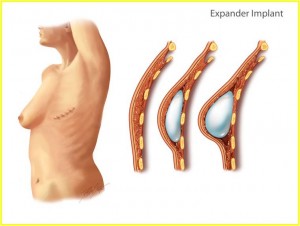Breast Cancer Part 4: Reconstruction with Implants
October 30th, 2014
Choices in Reconstruction
Breast cancer is the most commonly diagnosed cancer in US women. Research has found that breast reconstruction contributes to a woman’s self-esteem and sense of wellbeing; however, over 70% of women eligible for breast reconstruction are not told about all of their options. Breast reconstruction generally falls into two categories: implant reconstruction or reconstruction using a person’s own tissue, also known as autologous reconstruction.
We discussed breast reconstruction with fat transfer and reconstruction with flap techniques in previous blogs. Today we will complete our educational series by discussing implant based reconstruction. No matter what your choice, breast reconstruction is inherently staged. This means it will involve multiple procedures, each being one of the stages, to achieve an optimal outcome.
Implant Based
A temporary expander, placed under the pectoral muscle, creates a pocket, which will eventually accommodate a permanent silicone or saline implant. This procedure frequently requires an overnight stay in the hospital and has a recovery time of several weeks. Expansion starts a few weeks after the first surgery after the incisions have healed. The expansion process requires multiple office visits and may take anywhere from two months to one year based on the individual needs and desires of the patient. Once the expansion is complete, the expander is exchanged for an implant during an outpatient surgical procedure. Additional procedures may be required to achieve the desired appearance, shape and symmetry.
Implants are manmade and will eventually fail. Rupture rates are similar for saline and silicone implants and average between 20-25% at 10 years. After 10 years, the rupture rate increases significantly. When a saline filled implant ruptures, your body safely reabsorbs the fluid and the reconstructed breast will flatten as a result. Silicone is a synthetic product and may go undetected when it ruptures. Instead, tissues may become inflamed, causing complications with scar tissue and calcification. When a silicone implant ruptures, it should be replaced promptly. Since silicone ruptures are often silent ruptures, the FDA recommends that women with silicone implants undergo an MRI test three years after having the implants placed and every two years thereafter. This maintenance is an additional personal and financial responsibility for the woman choosing silicone implants.
If you are diagnosed with breast cancer, you have many choices to make so take the time to make the right ones. Immediate reconstruction is safe, but you are not necessarily burning any bridges by delaying your reconstruction for personal reasons. Overcoming breast cancer is a journey and you are not alone. Speak with your primary care physician, breast surgeon and plastic surgeon about your options and help them make the decisions that will give you the best quality of life in the long run. Please click here if you missed Part 1, Part 2, Part 3 of our series.
Photo: Breast Reconstruction with Expander/Implant.
Breast Cancer: Knowledge is Power Part 1
October 16th, 2014
October is Breast Cancer Awareness Month. One in eight US women will be diagnosed with breast cancer. We are posting this multi-part series and the new posts will address the choices women have for the treatment and reconstruction of breast cancer. Breast cancer is the most common cancer among women in the US. Many women are understandably distraught by the news they have breast cancer and feel a sense of urgency to make important decisions regarding their care. Surgery to treat breast cancer can have a significant impact on quality of life and yet many women feel pressured to make these decisions. Overcoming breast cancer is a journey and a very individual one that involves choices about the type of breast surgery, the need for additional treatments (chemotherapy or radiation) and options for breast reconstruction. Research has found that breast reconstruction contributes to a woman’s self-esteem and sense of wellbeing; however, over 70% of women eligible for breast reconstruction are not told about all of their options.
Knowledge is power. As a plastic surgeon, it is our role to make sure my patient knows and understands all of her reconstructive options before her cancer is treated and removed. Every woman diagnosed with breast cancer should seek a referral to a plastic surgeon. Ultimately, knowledge is power and breast reconstruction is about choosing the option that will give you the best possible quality of life. Each person is driven by different motives and sensitivities, personally unique to their own individual circumstances.
Next time: Take Time to Make the Right Decisions Part 2

